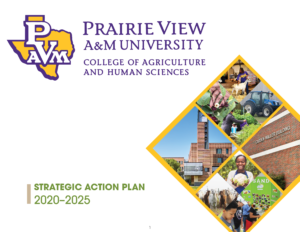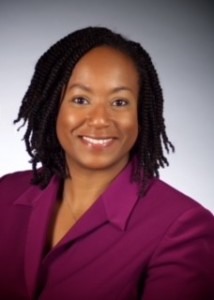By Tucker Wilson
 June 1 – Prairie View A&M University’s College of Agriculture and Human Sciences’ first-of-its-kind virtual college-wide meeting on May 13 could be described as an efficiency triumph. The meeting themed, New Beginnings, started at 8:30 a.m. with a how well do you know your colleagues’ game of Kahoots as an ice-breaker that, by all accounts, was a hit.
June 1 – Prairie View A&M University’s College of Agriculture and Human Sciences’ first-of-its-kind virtual college-wide meeting on May 13 could be described as an efficiency triumph. The meeting themed, New Beginnings, started at 8:30 a.m. with a how well do you know your colleagues’ game of Kahoots as an ice-breaker that, by all accounts, was a hit.
Moderator Dawn E. Burton announced 1st through 3rd place winners, Vanessa Wright, Samuel Sampson, and Ashley Pellerin, respectively, and relinquished the floor to CAHS Dean and Director of Land Grant Programs, Gerard D’Souza.
More than 140 participants tuned in to the virtual meeting: faculty, and staff, including multiple county agents, who logged in from all over the state of Texas. The meeting’s focus centered around the review of the college’s new Strategic Plan 2020-2025, which D’Souza said came about as a result of collective teamwork. “It provides us with a roadmap of where we need to be headed,” he added and began a 20-minute presentation that outlined his goals of building relationships and partnerships. Those goals also served as the central theme of his presentation. “We have what I consider to be pillars of the college, and these include the mission areas and the farm. These pillars are already strong but can be strengthened to support the college that we want to become, the college we aspire to, a college of the first class that attracts investors, students, faculty, staff, and that can maximize its impact and outreach in the underserved communities that we serve,” D’Souza said.
CAHS Human Resources Liaison, Kimbria Worley, provided an introduction of new colleagues and announced Louis Nuti as the college’s lone upcoming retiree.
Following the first five-minute break, and after D’Souza’s State of the College, Samuel Sampson delivered a presentation titled, History and Highlight of the Strategic Action Plan Process. During the presentation, he paid homage to CAHS’ Executive Associate Director for Extension, Carolyn J. Williams, for her leadership and expressed a special county shout-out to acknowledge the numerous county agents in attendance.
Sampson’s presentation gave a detailed, behind-the-scenes glimpse of the history and highlights of the strategic plan process. “As the dean rightly said, we began with his vision and incorporated all aspects of the college,” Sampson said. He added that all aspects of the college were tasked to review and help lead the college in a new direction. The presentation also included the plan’s timeline, the number of taskforces, as well as taskforce’s objectives, information about the decision-making process, meetings, and suggestions. A survey designed to gather feedback about the previous strategic plan was also a part of the process. The consensus was to keep the last strategic plan but make changes, and that’s how the taskforce laid the foundation for the current plan. There was also a question regarding changing the name of the college. The consensus was to rename to the College of Agriculture, Food and Life Sciences.
Ms. Burton reminded everyone that the strategic plan is not finalized. “The document we’ve asked you to review is a combination of everyone’s input, the research, and the strategic method that was engaged. A lot of effort was put into this document. The plan is not finalized because we want to gain a consensus. We’ve requested everybody’s feedback because we want to be transparent in making sure that everybody’s on board with the change that’s going to come,” Burton said.
Back at the meeting’s helm, D’Souza responded to feedback and questions. The meeting’s virtual format provided opportunities for interactive participation. After a question from new adjunct faculty member Misha Chakraborty about whether the college plans to focus on essential skills, D’Souza called on Associate Professor Wash A. Jones to elaborate on the college’s current emphasis on teaching essential skills. Jones addressed the need for faculty to incorporate these skills in their curricula, “We are aware that is a need, so we are trying to find ways beyond the classroom that’s going to help them (students) develop those skills, such as going to various conferences, and workshops, and we try to get our students involved when there’s an opportunity for our students.” He pointed to various opportunities such as, the Agriculture Futures of America, and the Agriculture Diversity Conference in Washington, D.C. Jones also mentioned the need to bring industry professionals in to help stress the importance of those skills to students.
D’Souza added this is an area where college alums can aid, and stressed the need to rely on them as a resource to students. Concerning the topic of essential skills, Executive Associate Director for Extension, Carolyn Williams, reminded colleagues that, as a college rich in resources, extension agents are and have always focused on essential skills while working with young people. “This is an awesome opportunity to bring some of our extension staff to come to your classes and speak to your students about these skills. Several agents and specialists would share essential skills and ways for (students) to beef up their resumes,” Williams said. Williams added such visits would be an excellent opportunity to expose students to the extension side of agriculture.
Two real-time polls, designed to gauge the college’s response toward accepting the new strategic plan, were included during the meeting. The college-wide meeting had something for everyone, and provided a platform for full transparency. From questions about updates on college-related construction projects like the new meats’ lab to the possible creation of a big data analysis center, faculty member’s course loads, and the multi-phased return to campus plan, no topic was off-limits.
In closing, D’Souza thanked everyone for attendance and participation and ended with words of encouragement. While the college-wide meeting ended early, D’Souza remained online and engaged participants in an additional Q&A session.
The virtual format was different, with its noted advantages, a large number of participants, interactive engagement opportunities, and the chance for colleagues to log in following a lengthy period of isolation. It’s safe to say, although it was the first college-wide meeting of its kind, don’t be surprised if the format is revisited in the future.
 For more information, please contact:
For more information, please contact:
Dawn E. Burton
Health Coordinator
Cooperative Extension Program
Email: Dawn.Burton@ag.tamu.edu
Voice: 713.797.7032
This work was supported by the USDA National Institute of Food and Agriculture, 1890 Extension Formula Program projects under Section 1444.
